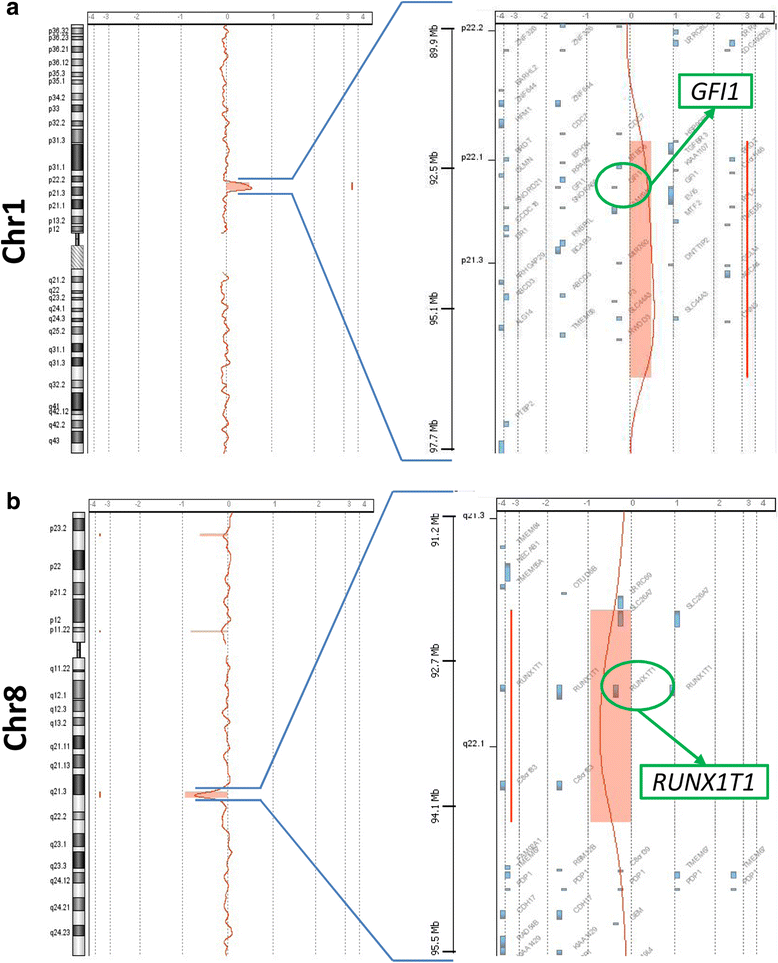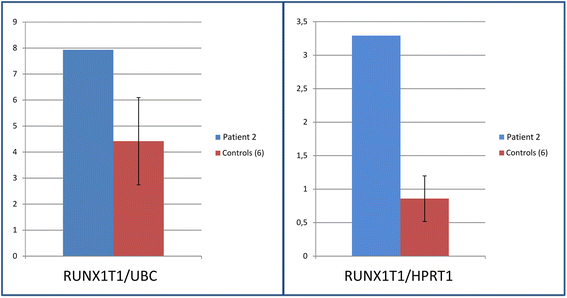Bone marrow failure may be caused by chromosome anomalies exerting effects on RUNX1T1 gene
- PMID: 29344089
- PMCID: PMC5765665
- DOI: 10.1186/s13039-017-0352-2
Bone marrow failure may be caused by chromosome anomalies exerting effects on RUNX1T1 gene
Abstract
Background: The majority of the cases of bone marrow failure syndromes/aplastic anaemias (BMFS/AA) are non-hereditary and considered idiopathic (80-85%). The peripheral blood picture is variable, with anaemia, neutropenia and/or thrombocytopenia, and the patients with idiopathic BMFS/AA may have a risk of transformation into a myelodysplastic syndrome (MDS) and/or an acute myeloid leukaemia (AML), as ascertained for all inherited BMFS. We already reported four patients with different forms of BMFS/AA with chromosome anomalies as primary etiologic event: the chromosome changes exerted an effect on specific genes, namely RUNX1, MPL, and FLI1, leading to the disease.
Results: We report two further patients with non-hereditary BM failure, with diagnosis of severe aplastic anaemia and pancytopenia caused by two different constitutional structural anomalies involving chromosome 8, and possibly leading to the disorder due to effects on the RUNX1T1 gene, which was hypo-expressed and hyper-expressed, respectively, in the two patients. The chromosome change was unbalanced in one patient, and balanced in the other one.
Conclusions: We analyzed the sequence of events in the pathogenesis of the disease in the two patients, including a number of non-haematological signs present in the one with the unbalanced anomaly. We demonstrated that in these two patients the primary event causing BMFS/AA was the constitutional chromosome anomaly. If we take into account the cohort of 219 patients with a similar diagnosis in whom we made cytogenetic studies in the years 2003-2017, we conclude that cytogenetic investigations were instrumental to reach a diagnosis in 52 of them. We postulate that a chromosome change is the primary cause of BMFS/AA in a not negligible proportion of cases, as it was ascertained in 6 of these patients.
Keywords: Chromosome 2; Chromosome 8; Chromosome structural anomalies; Pancytopenia; RUNX1T1 gene; Severe aplastic anaemia.
Conflict of interest statement
Informed consent to this study was obtained according to the principles of the Declaration of Helsinki from the patients, the patients’ parents, and from healthy controls.Informed consent for publication was obtained from the patients, the patients’ parents, and from healthy controls.The authors declare that they have no competing interests.Springer Nature remains neutral with regard to jurisdictional claims in published maps and institutional affiliations.
Figures




References
-
- Marletta C, Valli R, Pressato B, Mare L, Montalbano G, Menna G, et al. Chromosome anomalies in bone marrow as primary cause of aplastic or hypoplastic conditions and peripheral cytopenia: disorders due to secondary impairment of RUNX1 and MPL genes. Mol Cytogenet. 2012;5:39. doi: 10.1186/1755-8166-5-39. - DOI - PMC - PubMed
LinkOut - more resources
Full Text Sources
Other Literature Sources
Research Materials
Miscellaneous

